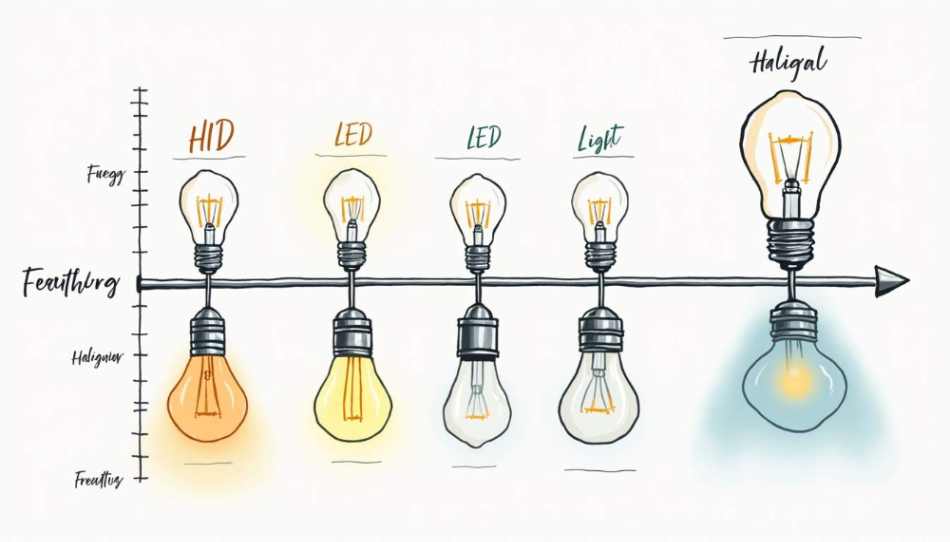High-Intensity Discharge (HID) lighting has emerged as a popular choice for night driving, offering superior brightness and efficiency compared to traditional lighting systems. This article delves into the fundamentals of HID lighting, its advantages, comparisons with other lighting technologies, installation tips, and potential drawbacks, providing comprehensive insights for those considering this lighting upgrade.
Understanding the Basics of HID Lighting
HID lighting systems are known for their powerful illumination, which is particularly advantageous for night driving. The technology uses an electric arc between two electrodes in a gas-filled bulb to produce light. Unlike conventional incandescent bulbs that rely on a filament, HID lights offer a distinct mechanism for generating brightness.
What is HID Lighting?
HID lighting consists of a sealed glass tube filled with gas, typically xenon and metallic salts. When an electric current passes through this gas, it ionizes, resulting in a bright, bluish-white light. This advanced lighting system is preferred for its higher lumen output per watt, making it more efficient than traditional light sources. The distinct color temperature of HID lights, often ranging from 3000K to 6000K, not only enhances visibility but also provides a more natural light that can reduce eye strain during long periods of driving.
The Science Behind HID Lighting
The fundamental principle behind HID lighting lies in the ionization of gases. When electricity flows through the gas, it excites the gas particles, causing them to emit photons when they return to their normal state. This reaction generates an intense light source that can significantly enhance visibility during nighttime driving. Additionally, the efficiency of HID lighting means that less energy is wasted as heat, allowing for a cooler operating temperature compared to traditional bulbs, which can prolong the lifespan of the lighting system.
Components of HID Lighting Systems
A typical HID lighting system comprises several key components:
- Ballast: Regulates the electrical flow to the bulbs, ensuring they receive the proper voltage to ignite and operate efficiently.
- Bulb: The source of light, which utilizes xenon gas to produce illumination.
- Igniter: A crucial part that provides the initial voltage surge required to start the bulb.
Each of these components works together to ensure optimal performance and longevity of the HID lighting system. Furthermore, the ballast is often equipped with advanced technology that allows it to adapt to varying conditions, ensuring consistent light output regardless of fluctuations in voltage. This adaptability is particularly beneficial in automotive applications, where reliable lighting is critical for safety.
Moreover, HID lighting systems have gained popularity not only in automotive applications but also in various commercial and residential settings. Their ability to illuminate large areas with minimal energy consumption makes them ideal for streetlights, parking lots, and even indoor spaces like warehouses. As the demand for energy-efficient lighting solutions continues to grow, HID systems are being increasingly recognized for their role in sustainable lighting practices, contributing to reduced carbon footprints and lower electricity bills.
The Benefits of HID Lighting for Night Driving
Switching to HID lighting can offer multiple advantages, particularly for night driving. Understanding these benefits can help drivers make informed decisions about their vehicle lighting options.
Enhanced Visibility with HID Lights
The forefront benefit of HID lighting is the intense brightness it provides. With a color temperature ranging from 4000K to 6000K, HID lights deliver better visibility compared to standard halogen bulbs. This can be crucial in low-light conditions, improving reaction times and overall driving safety. Moreover, the bluish-white hue of HID lights allows for better contrast against road signs and markings, making it easier for drivers to navigate unfamiliar routes or challenging terrains.
Safety Advantages of HID Illumination
Increased visibility means improved safety on the road. HID lights illuminate a wider area and allow drivers to spot potential hazards earlier than with traditional lighting systems. The bright white light mimics daylight, helping reduce eye strain and enhancing focus while driving at night. Additionally, the ability of HID lights to penetrate through rain and fog can be a game-changer for drivers in inclement weather, providing clarity and confidence when visibility is otherwise compromised.
Durability and Longevity of HID Lights
HID lights are not only brighter but also more durable. Typically, they can last up to 2500 hours or more, substantially longer than halogen bulbs, which often need replacing after about 500 hours of use. This longevity offers cost savings over time, reducing the frequency of replacements. Furthermore, HID systems are less susceptible to vibrations and shocks, making them an ideal choice for off-road enthusiasts or those who frequently drive on rough terrain. The robust construction of HID lights ensures they can withstand the rigors of daily driving, providing peace of mind for drivers who rely heavily on their vehicle's lighting system.
Energy Efficiency of HID Technology
Another significant advantage of HID lighting is its energy efficiency. HID bulbs consume less power than traditional halogen bulbs while producing significantly more light. This means that vehicles equipped with HID lights can reduce their overall energy consumption, which can be particularly beneficial for electric or hybrid vehicles looking to maximize their battery life. Additionally, the lower energy draw can contribute to a reduced carbon footprint, making HID lighting a more environmentally friendly option for conscientious drivers.
Customization and Aesthetic Appeal
HID lighting also offers a level of customization that appeals to many vehicle owners. With various color temperatures available, drivers can choose the hue that best suits their style and driving needs. Whether opting for a cooler, more modern look or a warmer tone for a classic feel, HID lights can enhance the overall aesthetic of a vehicle.
Comparing HID Lighting with Other Lighting Technologies
As with any technology, it’s essential to compare HID lighting against other available options to determine the best fit for your vehicle's needs. Two primary competitors are halogen and LED lights.
HID vs. Halogen Lights
When comparing HID lights to halogen systems, the differences are striking. Halogen lights produce a warm yellowish light that can be less effective for night visibility. Additionally, HID lights usually consume less power while providing greater illumination, making them an attractive alternative for those seeking efficiency and brightness.
HID vs. LED Lights
LED lights have been gaining traction due to their efficiency and longevity. While they are comparable in lifespan to HID systems, HID lights typically provide a brighter output. However, LED technology continues to improve, and some high-quality LED options can now rival HID lighting's brightness and color temperature.
Installation and Maintenance of HID Lights
Installing HID lighting requires careful consideration and attention to detail to ensure proper functioning.
Steps to Install HID Lighting
Installing HID lights generally involves the following steps:
- Preparation: Gather necessary tools and materials, ensuring you have the correct HID kit.
- Remove the existing bulbs: Turn off your vehicle and safely remove the old halogen bulbs.
- Install the ballast: Secure the ballast in a suitable location in your vehicle.
- Connect wiring: Carefully connect the wiring from the ballast to the HID bulbs, ensuring proper insulation.
- Test the system: Turn on your vehicle to check that the HID lights function properly.
Tips for Maintaining Your HID Lights
- Regularly inspect the headlights for any sign of condensation or soot buildup.
- Ensure all connections remain tight and insulated to prevent electrical issues.
- Replace bulbs in pairs to maintain consistent brightness and lighting patterns.
Potential Drawbacks of HID Lighting
Legal Considerations for HID Lights
HID lights may not be legal in all regions or may require specific adjustments to comply with local regulations.
Potential Glare Issues with HID Lighting
Improperly aligned HID lights can cause significant glare for oncoming drivers, posing a safety risk on the road.
In conclusion, HID lighting represents a powerful solution for night driving, offering exceptional brightness, efficiency, and safety.














